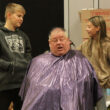Sean C. Morgan
Of The New Era
Members of the public attending an informational meeting Thursday night were divided about the construction of a marina on Foster Lake.
A couple dozen members of the public attended the meeting, which was organized by Foster Lake Investments, the development company building Edgewater Resort and Marina and the second homes on the southwest shore of Foster Lake.
Steve Leith, one of three partners in the project, explained that planning the marina meant some tradeoffs in relation to other uses of the lake. He and his partners, Dan McGarry and Dennis Gibson, all of Corvallis, attempted to minimize those impacts as they planned the marina, he said.
The proposed marina would extend approximately 295 feet from shore and be approximately 635 feet long, including 155 slips in four rows that parallel the shore. The west end extends about to the end of the trees growing on a bench commonly used for swimming and fishing.
It includes approximately 3 acres of the lake’s surface, Leith said. The lake has approximately 1,000 acres of surface area.
During low water, about 115 slips would be usable, Leith said. The first row would continue floating, but the water would be too shallow to use. Slips will be available for weekly, monthly and seasonal rent. Courtesy slips also will be available. Large slips at the ends of the docks could accommodate boats up to 35 feet long. Most slips are 20 feet long.
The marina would be anchored by concrete blocks and galvanized chain, causing less impact to the lakebed than driving piles and exposing fewer parts to corrosion, Leith said. The marina is designed to automatically rise and fall with the lake level.
The marina itself would float on 18-inch pontoons, Leith said, essentially plastic pipe filled with foam and capped on the ends. The marina will be surrounded by similar pipes to create a “wave attenuation structure.”
The developers considered impacts to bank fishing, bank swimming, carrying capacity of the lake and biological, environmental, cultural and operations concerns, Leith said. The developers’ goal was to balance the impacts to different use groups.
The biggest impact would be no swimming inside the wave attenuation structure, Leith said. Bank fishermen would still be able to fish from the shore.
Whether the 200-foot no-wake zone along shore will be extended from the edge of the marina is a decision that will be made by the Oregon Marine Board, Leith said. The developers are talking to the Marine Board, and they don’t believe the no-wake zone needs to be extended with the wave attenuation structure in place.
Leith explained in detail how he calculated the marina’s biggest impact, based on a number of research sources, on the carrying capacity of the lake, assuming that all of the slips were rented by new users and that the maximum number of those marina users, approximately 30 percent, were using the lake at any given time.
If that happened, the lake would still have room left or be just over its capacity, Leith showed. His data relied on average annual lake usage figures compiled by the Marine Board.
Data on summer usage or breakdowns by month were not available, Leith said.
Critics pointed out that the use of the lake is not spread out through the entire year, with the winter months receiving almost no usage. That means that the lake is fuller during the months it is in use, and they were concerned that the lake would reach its maximum capacity during those periods.
Generally, based on anecdotal evidence in research, marinas do not attract new users, Leith said, but rather those who already use the lakes take advantage of them, which also redistributes use patterns. People using the marinas will sometimes hold off using lakes until the lakes are less crowded.
“I personally don’t believe the marina is going to increase congestion,” Leith said.
Some at the meeting were also concerned that the marina would take out the “cemetery run,” a waterskiing route that runs from Lewis Cemetery across the west end of the lake and up the south edge of the lake before the skiers return to the cemetery area on the north side of the lake. Extending the no-wake zone would make it more likely to affect what they described as a popular run.
A fisherman told Leith that the boats heading into the marina would interfere with bank fishing on the southwest bench. The fisherman said he has had his lines cut by boat propellers.
One critic said he didn’t think that any private operation should be permitted on the public waters. Edgewater would lease the area from the U.S. Army Corps of Engineers if the Corps approves the marina. It would be open to anyone who wants to rent a slip.
About a half dozen persons were critical or opposed the development of the marina, while four or five told Leith they supported the development of the marina.
The Corps of Engineers had representatives at the meeting, which was primarily aimed at explaining the project and arming citizens with information about the project prior to a public hearing on the matter, possibly by the end of June. Documents will be available for review in person and also via the Internet within a couple of weeks.




